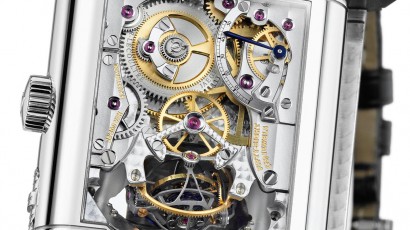
Watch Snob: Is It OK To Sell An Heirloom Watch?
Watch Snob: Is It OK To Sell An Heirloom Watch?

Jaeger LeCoultre
“Despite my reverence for the tradition of watchmaking, I do not set out to deliberately collect vintage timepieces; I buy watches of significance that I like, whether old or new.“
The Watch Snob is in.
Hand-Me-Down Watch Etiquette
Is it ever acceptable to sell a watch handed down to you from an older generation? My great grandfather gave me a vintage Rolex Datejust Ref. 1601. The problem is that it’s a two-tone gold and stainless model.
I don’t think I would ever wear it, but my first instinct is to save it for my son. I certainly like the idea of passing it along to the next generation, and perhaps he will like and wear it. Recently, I’ve been asking myself whether or not I want to find out if I have the kind of child who would wear a two-tone Rolex; it’s in his genes, after all. Should I sell it, buy a Reverso and put it away for him, or should I be ashamed for even considering the sale of a family heirloom?
Fret over this no longer. It is perfectly acceptable to sell a handed-down watch, especially a two-tone Rolex. You’ll even spare your son the same dilemma after you shuffle off this mortal coil. I think your grandfather, being the kind of man who handed down a timepiece in the first place, would appreciate your desire to turn his old watch into something of your own. Besides, if you do buy a Reverso or another watch that you will actually wear, it will mean more to your heir when you pass it to him one day, since he will have seen it on your wrist rather than a dusty old watch from a man he never knew.
Universal Genève watches
I’ve had a fascination with vintage Universal Genève watches for a while. How would you rank them in the pantheon of great watchmakers, and what do you think of them as vintage pieces?
I am the first to admit that, despite my reverence for the tradition of watchmaking, I do not set out to deliberately collect vintage timepieces; I buy watches of significance that I like, whether old or new. Having said that, I share your soft spot for the Universals of yore, and they may just be the best value in vintage watches today. While Universal is still in business, some poor business decisions and ill-conceived designs castrated them and today they are a mere shadow of their former glory.
For those readers who can’t look past the shiny brands that are sold in shopping malls, Universal was a maker of beautiful and innovative watches in the 1950s and ‘60s. Its Polerouter of the 1950s was the first watch designed by Gerald Genta, who went on to become the most important watch designer of the next two decades. Universal Genève was particularly known for its chronographs, and if you can find a vintage Tri-Compax, don’t hesitate. It is a legitimate haute horlogerie complication piece and usually can be had for less than what most of you paid for your banal TAG or Omega.
How long can a watch sit without running before someone should be concerned? I’m sure a day or two may not do much harm to the oils inside of a movement, but where should someone draw the line?
Let me guess: You’re someone who checks to see if Grandpa is still breathing every few minutes when he naps in his chair. Well, unlike Gramps, with a watch, there’s no need for concern unless you found it in a sock drawer or at the markets, in which case, you’d be wise to have it serviced.
It’s a trade-off, really. If a watch runs constantly, friction will wear parts down faster than if it sits unwound. But if it sits idle for any length of time, the oils pool and become viscous. For me, this dilemma is a moot point. I just wear my watches and have them serviced every now and then when their precision slips out of an acceptable range. But I suspect your obsessive-compulsive brain will debate these scenarios to the point of madness.
Watch Snob’s Free Newsleetter
Thanks for subscribing!